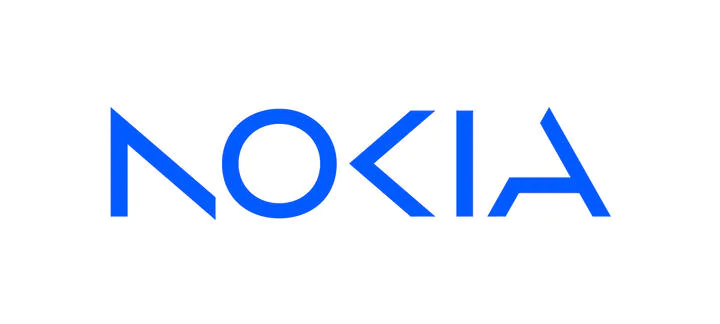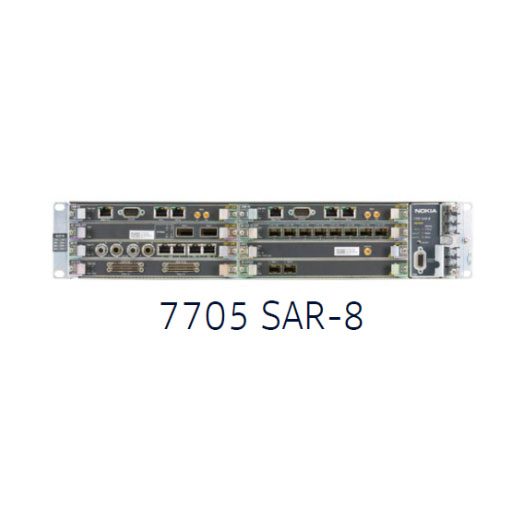Nokia 7705 SAR-8
Service Aggregation Router
The Nokia 7705 SAR-8 Service Aggregation Router offers a comprehensive set of T1/E1, T3, SONET/SDH, serial data, electrical utility teleprotection and analog voice interfaces along with software features for asymmetrical delay and jitter compensation. These interfaces and features ensure that legacy applications perform exactly as they did on TDM networks.
Nokia 7250 X Series Product Family
Nokia 7250 Interconnect Router-X series (IXR-X series) routers1 are high-speed, high-density 1RU platforms. They are ideal as leaf nodes in data centers and multi-access edge computing nodes and are valuable for access and aggregation as well as 5G interconnectivity.
There are three platforms in the IXR-X series: the 7250 IXR-Xs, 7250 IXR-X1 and 7250 IXR-X3. Using these routers, network operators can efficiently scale up bandwidth to prepare for future growth requirements.
Features & Benefits
- The 7705 SAR portfolio offers a comprehensive set of T1/E1, T3, SONET/SDH, serial data, electrical utility teleprotection and analog voice interfaces along with software features for asymmetrical delay and jitter compensation. These interfaces and features ensure that legacy applications perform exactly as they did on TDM networks. To ensure application performance, mission-critical traffic is expedited when using either high-speed Ethernet or legacy low-bandwidth links. Numerous migration features allow network operators to gracefully move their applications onto their new IP/MPLS/segment routing network.
-
The depth of its IP/MPLS/segment routing protocol implementation and robust operations, administration and maintenance (OAM) capabilities at all levels set the 7705 SAR apart from its competitors. A thorough implementation of the standards provides greater resiliency and more options and flexibility for service definition.
The 7705 SAR’s IP and MPLS scalability gives operators the potential to grow their networks, adding many end users and applications without having to make additional capital investment. The 7705 SAR provides excellent resiliency to link or equipment failures through redundancy and the ability to quickly reroute traffic.
The 7705 SAR delivers network reconvergence in tens of milliseconds using a strong suite of dynamic routing and recovery capabilities. Superior network resiliency reduces network down time and improves the productivity of operations staff, helping to reduce operating costs, improve end-user satisfaction, and allowing service providers to offer higher-value service level agreements (SLAs).Robust security
- The 7705 SAR provides a robust set of security features to maintain network integrity in the face of cyberattacks such as session hijacking, spoofing and denial of service (DoS) attacks. The 7705 SAR firewall is application-aware and mitigates attacks such as Domain Name System (DNS)/Internet Control Message Protocol (ICMP) replay. Application-level gateways ensure extra security for FTP/T-FTP connections. Hardwarebased encryption features, including IPsec, Network Group Encryption (NGE) and advanced key exchange algorithms, prevent man-in-the-middle attacks. All 7705 SAR security features provide high throughput levels while minimizing latency. The portfolio is FIPS 140-2 compliant on both the control and data planes. Operators can use the 7705 SAR to safeguard critical infrastructures and address regulatory requirements such as North American Electric Reliability Corporation (NERC) Critical Infrastructure Protection Version 5 (CIP V5).
- The Nokia SR 0S software provides superior quality of service (QoS) on the 7705 SAR. The same level of deep buffering and support for ingress and egress shaping that is available on Nokia’s edge and core routing platforms is also available on the 7705 SAR aggregation platform. Consistency of traffic engineering and shaping across the network provides higher packet routing performance overall with differentiated service treatment. This facilitates the convergence of fixed and mobile traffic for service providers as well as the convergence of operational and business services traffic for mission-critical network operators. The SR OS software allows for advanced service offerings and delivers efficient network resource usage, customer satisfaction and retention.
- The 7705 SAR provides microsecond timing and accurate synchronization to support mobile base station requirements and the migration of TDMbased services onto the packet network. Timing accuracy and performance over packet are enabled by a combination of built-in architectural features, integrated Global Navigation Satellite System (GNSS) receivers, Nokia Bell Labs algorithms, accurate hardware time-stamping, and powerful QoS mechanisms. Together, these capabilities minimize the delay and delay variation experienced by synchronization traffic.
- When used together, the 7705 SAR and Nokia Wavence microwave systems have a number of features that improve routing performance and resiliency over microwave links. A 7705 SAR and its subtending microwave systems are treated as a single network element with one IP address, simplifying operations and administration. This allows for bandwidth notification, IEEE 1588 synchronization, faster fault detection, and rerouting with various microwave redundancy architectures supported. The microwave systems can be powered from the 7705 SAR system, reducing space requirements and cost.
- The 7705 SAR portfolio is packaged in a wide range of form factors to accommodate the density and types of services required at any location. It provides both indoor and outdoor mounting solutions combined with extended temperature range and power-over-Ethernet (PoE) options. Fanless and conformal-coated variants allow the 7705 SAR to be used in harsh environmental conditions. The 7705 SAR platforms are mechanically hardened with a robust electromagnetic compatibility (EMC) design. Several platforms comply with the IEEE 1613, IEC 61850-3 and EN 50121-4 standards for power substations and railway environments.
Easy legacy TDM migration
Routing and resiliency
Quality of service
Precise timing and synchronization
Microwave awareness
Field longevity
Software Features
- Point-to-point Layer-2 virtual private network (VPN) services
- Ethernet VPN - Virtual Private Wire Service (EVPN-VPWS)
- Virtual leased line (VLL)/pseudowire
- Targeted Label Distribution Protocol (T-LDP)- based ATM, Frame Relay High Level Data Link Control (HDLC), IP, Ethernet and TDM pseudowires
- Multipoint Layer-2 Virtual Private LAN Service (VPLS)
- EVPN-VPLS
- Route type 2: MAC/IP advertisement
- Route type 3: Inclusive multicast (without point to multipoint communication) Ethernet tag route for broadcast, unknown unicast and multicast traffic
- Route type 4: Multihoming with single active and active-active
- Route type 5: IP reachability
- T-LDP-based VPLS
- IP VPN services (IPv4 and IPv6)
- Internet Enhanced Service (IES)
- Circuit Emulation Services (CES)
- Structure Agnostic TDM over Packet (SAToP)
- CES over Packet-Switched Network (CESoPSN)
- Metro Ethernet Forum (MEF) 8 - Implementation Agreement for the Emulation of PDH Circuits over Metro Ethernet Networks
- Asymmetric delay control with active/active and active/standby network redundancy
- Raw socket IP transport for asynchronous RS-232 serial data
- Ethernet
- Packet over SONET/SDH (POS)
- ATM, ATM-Inverse Multiplexing for ATM (ATM-IMA)
- Frame Relay
- HDLC
- Point-to-Point Protocol (PPP), Multi-Class PPP (MCPPP), Multi-Link PPP (MLPPP)
- TDM
- Segment routing (SR)
- Intermediate System-to-Intermediate System (SR-ISIS) and Open Shortest Path First (SR-OSPF)
- Traffic engineering (SR-TE)
- MPLS Label Edge Router (LER) and Label Switch Router (LSR) functions
- Resource Reservation Protocol - Traffic Engineering (RSVP-TE)
- RSVP-TE Label Switched Path (LSP) shortcuts for Interior Gateway Protocol (IGP) route resolution
- Path Computational Element Protocol (PCEP) support
- LDP with loop-free alternate (LFA) and remote LFA (rLFA)
- IP routing
- IS-IS (IPv4, IPv6)
- OSPFv2 and OSPFv3
- Constraint-based Shortest Path First (CSPF)
- Routing Information Protocol (RIP) Border
- Gateway Protocol (BGP) with multiprotocol extensions
- BGP label unicast routes as defined in RFC 3107
- IPv6
- IPv6 VPN Provider Edge (6VPE) for MPLS and IPsec VPRN
- Dynamic Host Configuration Protocol (DHCP)
- v6 server/relay
- IPv6 over IPSecv4 tunnels
- LDPv6
- Multicast functionality at L3 and L2
- L2 multicasting via Internet Group Management Protocol (IGMP)/Multicast Listener Discovery (MLD) snooping in VPLS with traffic flow from L3 to L2
- IGMP/MLD snooping translation into Protocol Independent Multicast (PIM) for Routed VPLS (RVPLS)
- Protocol Independent Multicast – Source Specific Multicast (PIM-SSM) with both IGMPv1/2/3 and MLD v1/2 LDP
- Next-generation multicast VPNs (NG-MVPN) over MPLS encrypted via NGE
- PIM (SM, SSM) stitching via L2 PIM snooping
- Next generation multicast VPNs with MP-BGP MVPN-IPv4 address family and dynamic MLDP PMSI tree
- T-LDP
- Generic Routing Encapsulation (GRE)
- Topology discovery: BGP-Link State (BGP LS)
- IPv4 and IPv6
- PCEP support Load balancing and resiliency
- IEEE 802.3.ad Link Aggregation Group (LAG) and multi-chassis LAG
- Pseudowire redundancy
- Primary and secondary LSPs
- Fast reroute (FRR)
- BGP
- IP (OSPF and ISIS)
- RSVP-TE
- LDP with LFA and rLFA
- LDP LFA via SR stitching
- SR with rLFA and topology independent LFA (TI-LFA)
- Automatic Protection Switching (APS) and multi-chassis APS for SONET/SDH
- IPv4 and LDP LSR equal-cost multi-path (ECMP)
- Virtual Router Redundancy Protocol (VRRP)
- Entropy label (RFC-6790)
- Line card redundancy (LCR) for DS1/E1 ports Non-stop routing, non-stop services
- ITU-T G.8032v2 Ethernet ring protection switching Quality of service and traffic management
- Hierarchical QoS (H-QoS)
- Intelligent packet classification, policing, scheduling
- Deep buffering
- Ingress and egress shaping on per forwarding class, service access point (SAP) or VLAN, per customer multiservice site (MSS) and port basis
- IEEE 802.3ah: Ethernet in the first mile
- IEEE 802.1ag: Connectivity fault management
- ITU-T Y.1731: Fault and performance management
- LSP/MPLS statistics
- Microwave performance statistics
- Port mirroring (local/remote)
- Two-Way Active Measurement Protocol (TWAMP), TWAMP light
- ITU-T Y.1564 (RFC 2544) test head
- Per-port and per-SAP loopback with MAC swap
- 10 ms Bidirectional Forwarding Detection (BFD)
- Micro-BFD on LAG
- Cflowd including IPFIX
- Auto configuration (plug-and-play) with VLAN discovery
- Event handling system (EHS)
- Simple Network Management Protocol (SNMP) v3
- Secure Shell (SSH)
- Hash-based message authentication code (HMAC) secure hash algorithms (SHA2)
- Strong prime numbers for Diffie-Hellman (DH) key exchange
- Dot1x tunneling
- IP Security (IPsec) encryption over MPLS
- L2 services (VLL, VPLS over GRE) over IPsec
- TCP Maximum Segment Size (MSS) adjustment for IPsec
- Transport layer security (TLS 1.2, TLS 1.3)
- Network address translation (NAT)
- Stateful firewall with multi-channel support
- NGE for IP/MPLS services, L3 user and control traffic, and select L2 control traffic
- Public Key Infrastructure (PKI) supporting X.509v3 certificates, Certificate Management Protocol version 2 (CMPv2), Certificate Revocation List (CRL), Online Certificate Status Protocol (OCSP), RSA/DSA keys
- FIPS 140-2 compliant
Each product model supports, but is not limited to, a variation of the following features. Please refer to 7210 SAS technical documentation for the features supported on each product
Services
Interfaces
Network protocols
SDN
Operations, administration and maintenance
Security







